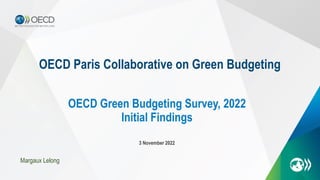
5-OECD-Green-Budgeting-Survey-2022.pdf
- 1. OECD Paris Collaborative on Green Budgeting 3 November 2022 OECD Green Budgeting Survey, 2022 Initial Findings Margaux Lelong
- 2. Introduction 2 I. Introduction II. Overview • Institutional arrangements • Methods and tools • Accountability and transparency • Enabling environment in budgeting III Challenges and innovations
- 3. Introduction 3 Details of the OECD building blocks OECD Green Budgeting Framework ➢ Green budgeting refers to the integration of climate and environmental considerations into the government’s budgetary processes and practices. ➢ It uses the tools of budgetary policy-making to help progress climate and environmental objectives.
- 4. Overview > 36 respondents > 24 countries are implementing green budgeting, compared to 14 in 2021 and 2020 > Green budgeting is used mainly to inform political decision-making (17 countries) 4 Green budgeting in OECD countries, 2022 Green budgeting impacts in policy-making and budgetary governance
- 5. 5 Overview ➢ Countries have strengthened their green budgeting practices relative to 2021. ➢ The variation in practices reflects differences from when countries commenced green budgeting, the resources available and the policy agenda ➢ Areas for further gains are in the accountability and transparency arrangements.
- 6. Institutional arrangements 6 Legal basis Objectives ➢More than 50% of OECD implement a national environmental strategy and a net- zero emissions strategy ➢Consistent to an emerging practice, green budgeting is most often implemented through administrative instructions ➢Green budgeting is used mainly to progress climate mitigation objectives, but the focus on climate adaptation is increasing
- 7. Institutional arrangements 7 Scope of green budgeting ➢Green budgeting is being applied broadly – capital investment, discretionary spending and mandatory spending ➢The majority of OECD countries have implemented recovery plans in response to the COVID-19 health crisis – and have included climate and environmental considerations in these plans ➢In half of OECD countries (19), finance ministries are primarily responsible for the implementation of green budgeting, 13 countries have a shared responsibility between the ministry of finance and line ministries Green budgeting in recovery plans
- 8. Methods and tools 8 ➢There is no single approach on how best to commence green budgeting ➢Common tools are carbon pricing instruments, environmental impact assessments, green tagging, and reviews of harmful tax expenditure. ➢Emerging tools: ➢ carbon budgets ➢ medium-term tools ➢ green spending reviews
- 9. Accountability and transparency 9 ➢ 10 countries have implemented oversight mechanisms. ➢ 8 of them to monitor the compliance with green reporting requirements ➢ 5 to monitor green investment and spending targets ➢ 4 to estimate the cost impact of green initiatives on the economy, emissions and energy markets ➢ 3 to estimate the fiscal cost and impact of green initiatives by government ➢ 11 OECD countries monitor the implementation of green budgeting ➢ 15 countries report on the implementation of green budgeting ➢ Monitoring and reporting are mainly performed by the ministries of finance and the ministries of environment ➢ Emerging practice: ➢ Four countries have implemented a green budget statement ➢ Accounting, financial reporting disclosures Monitoring and reporting Oversight
- 10. Accountability and transparency 10 Civil society involvement in green budgeting Public availability of information ➢ 12 countries reported that they included civil society in the green budgeting process, an increase from eight countries in 2021 ➢ Country practices of involving civil society in green budgeting vary: commissions, public enquiries, citizens’ groups, etc. ➢ 14 countries made information on green budgeting available to the public
- 11. Enabling environment in budgeting > 10 OECD countries use performance budgeting to support the implementation of green budgeting and 7 use performance budgeting but have yet to link it to green budgeting > 9 OECD countries use programme budgeting as a link to green budgeting, 7 use programme budgeting but have yet to link it to green budgeting 11 Programme budgeting and green Performance budgeting and green
- 12. Enabling environment in budgeting > The most common components supporting the implementation of green budgeting were training and skills development within ministries of finance > 13 countries had implemented co-ordination mechanisms to improve green budgeting. > These practices have increased since 2021. 12 Capacity building mechanisms Coordination mechanisms
- 13. Main challenges and areas or further work 13 ➢ In 2022, respondents stated that the challenges from implementing green budgeting were from having sufficient: • Resources to develop green budgeting approaches. • Relevant knowledge or technical expertise. • Disaggregated data on climate change and environmental sustainability. • Guidance resources to support the use and dissemination of green budgeting.
